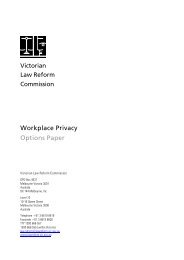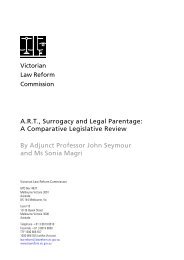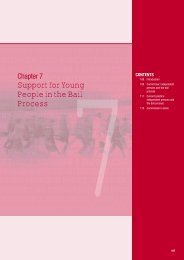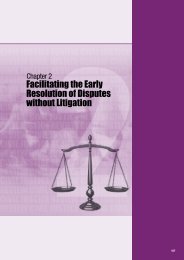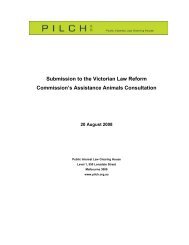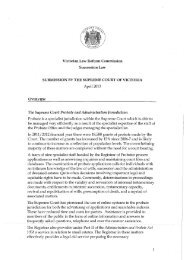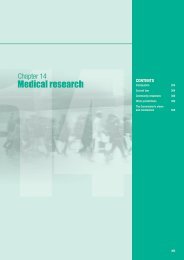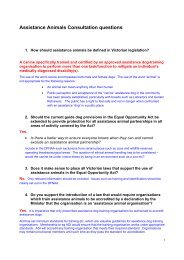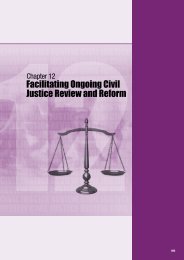Crimes Mental Impairment consultation paper.pdf - Victorian Law ...
Crimes Mental Impairment consultation paper.pdf - Victorian Law ...
Crimes Mental Impairment consultation paper.pdf - Victorian Law ...
Create successful ePaper yourself
Turn your PDF publications into a flip-book with our unique Google optimized e-Paper software.
<strong>Victorian</strong> <strong>Law</strong> Reform Commission<br />
Review of the <strong>Crimes</strong> (<strong>Mental</strong> <strong>Impairment</strong> and Unfitness to be Tried) Act 1997: Consultation Paper<br />
3.19 <strong>Mental</strong> illness is also more prevalent among prisoners compared with the general<br />
population. In 2012, the Australian Institute of Health and Welfare (AIHW) reported that<br />
almost a third (31 per cent) of the 610 prison entrants in the 2010 Census across Australia<br />
(excluding New South Wales and Victoria) reported a history of mental disorders. 13 The<br />
AIHW compared this to the self-reported prevalence of mental and behavioural problems<br />
recorded by the Australian Bureau of Statistics in 2009 in the general population (11 per<br />
cent). 14 In 2011, the <strong>Victorian</strong> Ombudsman reported that ‘[a]lmost one third of Victoria’s<br />
male prisoners have diagnosed mental health conditions’. 15<br />
3.20 This is consistent with many studies showing the overrepresentation of people with a<br />
major mental illness in prison populations. For example, Mullen, Holmquist and Ogloff<br />
reported that ‘up to 8% of male and 14% of females in… (Australian) prisons have a<br />
major mental disorder with psychotic features’. 16 The comparative lifetime prevalence rates<br />
for schizophrenia and psychotic disorders in the general population are 0.3 per cent to<br />
one per cent. 17 In referring to these studies and other research, it has been observed that:<br />
Rates of the major mental illnesses, such as schizophrenia and depression, are between<br />
three and five times higher in offender populations than those expected in the general<br />
community … The prevalence of mental illness is even higher in offenders remanded prior<br />
to trial. 18<br />
3.21 The overrepresentation of people with a mental illness in the criminal justice system does<br />
not mean that mental illness alone causes offending or a higher rate of re-offending:<br />
[W]hile most people with a mental illness do not offend, they are at greater risk for<br />
engaging in offending and violent offending than others in the community. Moreover, this<br />
risk elevates when the mentally ill person also has a co-occurring substance use disorder. 19<br />
3.22 Further, there are a number of factors that have been identified as contributing to the<br />
high numbers of people with mental illnesses in the criminal justice system, including:<br />
the deinstitutionalisation of mentally ill people, an increase in the use of drugs and alcohol<br />
by people with mental illnesses, and the limited capacity of community-based mental<br />
health services to address the needs of mentally ill offenders. 20<br />
3.23 The behavioural, emotional and cognitive problems that can be caused by a mental<br />
illness can present particular difficulties for people at various stages in the criminal justice<br />
system. These problems can make them more vulnerable and at greater risk of harm,<br />
particularly in the prison environment. 21 The disadvantages that are associated with<br />
mental illness, such as homelessness, poverty and risky behaviours, can also put people at<br />
greater risk of coming into contact with the criminal justice system. 22<br />
36<br />
13 This was measured ‘by the proportion that reported having been told at some time by a doctor, psychiatrist, psychologist or nurse that they<br />
have a mental health disorder’: Australian Institute of Health and Welfare, Australia’s Health 2012 (Australia’s Health series no 13 Cat no<br />
AUS 156, Canberra) 131.<br />
14 Australian Institute of Health and Welfare, Australia’s Health 2012 (Australia’s Health series no 13 Cat no AUS 156, Canberra) 131.<br />
15 <strong>Victorian</strong> Ombudsman, Investigation into prisoner access to health care (2011) 5.<br />
16 P E Mullen, C L Holmquist and J R P Ogloff, National forensic mental health scoping study (Department of Health and Ageing, 2003) 17.<br />
17 James R P Ogloff et al, ‘The Identification of <strong>Mental</strong> Disorders in the Criminal Justice System’ Trends and Issues in Criminal Justice, Volume<br />
334 (AIC, 2007) 2.<br />
18 Ibid 1–2.<br />
19 James R P Ogloff et al, ‘Policing Services with <strong>Mental</strong>ly Ill People: Developing Greater Understanding and Best Practice’ (2013) 48 Australian<br />
Psychologist 57, 66.<br />
20 Ogloff et al, ‘The Identification of <strong>Mental</strong> Disorders in the Criminal Justice System’ above n 17, 2.<br />
21 Ogloff, ‘Identifying and Accommodating the Needs of <strong>Mental</strong>ly Ill People in Gaols and Prisons’ above n 8, 2; <strong>Mental</strong> Health Legal Centre,<br />
Fact Sheet for the UN Special Rapporteur on the Right of Everyone to the Enjoyment of the Highest Attainable Standard of Physical and<br />
<strong>Mental</strong> Health (November 2009) Community <strong>Law</strong> at 1 May 2013.<br />
22 Eileen Baldry and Leanne Dowse, People with <strong>Mental</strong> Health and Disorders & Cognitive Disabilities in the Criminal Justice System in NSW:<br />
Policy and Legislative Impacts (2010) (New South Wales Department of Human Services: Ageing, Disability and Home Care) 1.



